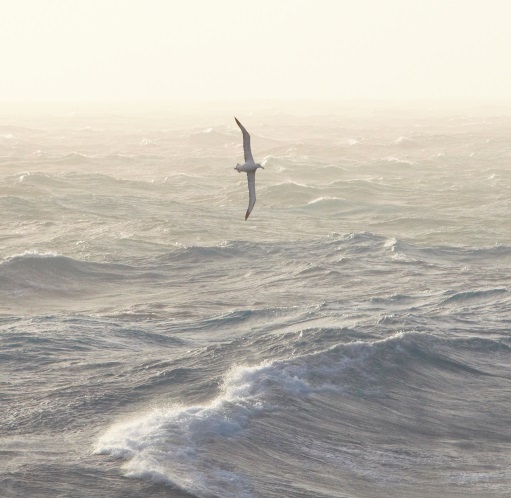New research published in Journal of the Royal Society Interface investigates the flight trajectory of the albatross.

New research published in Journal of the Royal Society Interface investigates the flight trajectory of the albatross. The study by Gabriel Bousquet, Michael Triantafyllou and Jean-Jacques Slotine found that the albatross is essentially a flying sailboat, and their findings could aid the development of wind-powered flying robots. We spoke to the authors about their research and their experience of publishing in Interface.
What inspired the study? Why the albatross?
We were first inspired by contests of remote-controlled (RC) model gliders performing dynamic soaring. RC enthusiasts go to windy mountain ridges and manage to utilise the non-uniform wind field in a clever way to extract energy from it. They reach more than 800 km/h with small span, hobby grade RC gliders.
However, the gliders stay circling around a single spot, and the practical value of the circling dynamic soaring manoeuvre is limited. Alternatively, albatrosses utilise a similar flight technique to propel themselves over the ocean, and may fly a thousand kilometres a day on wind power alone.
Why is the understanding of dynamic soaring important?
The importance of understanding dynamic soaring is two-fold. Firstly, it is aimed at helping biologists study the ecology of albatrosses and how it may be influenced by climate change. Secondly, understanding the albatross’ flight may open the way for conceiving bio-inspired, long-range wind-powered flying robots to monitor the oceans.
Recently, the techniques used for studying the albatross’ flight have drastically evolved. Since the 1970s, computer simulations and GPS recordings of the flight trajectory of albatrosses have enabled the development of data-driven studies and the use of ever-more complex dynamic models. We were looking through published data of flying albatrosses, and were surprised that they only turn by about 60 degrees, a third of the 180-degree half-turn description. Despite a deep bibliography search spanning 134 years, we did not find any explanation for this phenomenon.
We therefore went back to a reduced-order mathematical description of the system and realised that in the “thin shear limit”, conditions described by Lord Rayleigh, small-amplitude turns are in fact more efficient energetically than large ones (by a factor π/2). We exhibit a non-dimensional number characterising how “thin” is thin enough, thereby providing a quite general criterion. The result was confirmed by a 3D numerical study performed in-house, which converges to the analytic solution of our reduced-order mathematical model.
“Our results lead to a very intuitive explanation: the albatross is a flying sailboat.”
In theory, our model suggests that with a long enough ridge the RC-scale gliders would only need 30 knots of wind, instead of 50, to reach 800 km/h. More importantly, for ocean-going autonomous systems in light-wind conditions, a π/2 factor in efficiency may be the difference between sustained flight and forced water landing.
Our results lead to a very intuitive explanation: the albatross is a flying sailboat. If you think of a sailboat, it needs two appendages: a sail that extracts momentum from a fast medium (the wind), and a keel that injects this momentum into a slow medium (the water). The albatross sequentially flies in the wind layer, where it plays the role of a sail, and in the slow “boundary layer” (the first meter of the atmosphere, which is slowed down by frictional forces with the water surface), where it plays the role of a keel. As sailors know, the most efficient travel direction for a high-performance sailboat is crosswind, and so is it for albatrosses.
Why are these results important?
We think that relaxing the “half-turn” hypothesis is a conceptually fundamental and fruitful change of mind-set. The small-turn, “flying sailboat” image is very intuitive, and we believe that it is also a good starting point for mathematical models that may be nearly as simple as the one we presented in the Interface paper, and nearly as accurate as computationally intensive computer simulations. Having access to low-order, and yet accurate models, is potentially very useful in engineering, both for design and for control. In a nutshell, if you want to teach a glider to perform dynamic soaring by constructing a flight strategy in real-time, the class of algorithms that you can utilise is vastly different if it takes 10 seconds or 1 micro-second to estimate the performance of a possible trajectory.
Why did you submit to Interface?
This study is interfacial in many ways. We wanted to embrace the multi-disciplinarity of the research. We had five reviewers, and the review process was fast and efficient with a first submission in March 2017. The editorial process helped us improve the paper significantly.
We really hope to build a bridge between biologists and engineers. Dynamic soaring is a place where we believe cross-talk is important. Better observations of flying albatrosses may inform better algorithms for wind-powered flying robots. Additionally, flying robots may bring us valuable data to help understand the oceans better, in particular the interaction between waves and winds, which is important for biological and environmental studies.
“We really hope to build a bridge between biologists and engineers.”
We believe that the technology is getting ripe for albatross-inspired platforms, so we want to continue pushing in this direction.
Interface publishes cross-disciplinary research at the interface between the physical and life sciences, find out how to submit your research.




